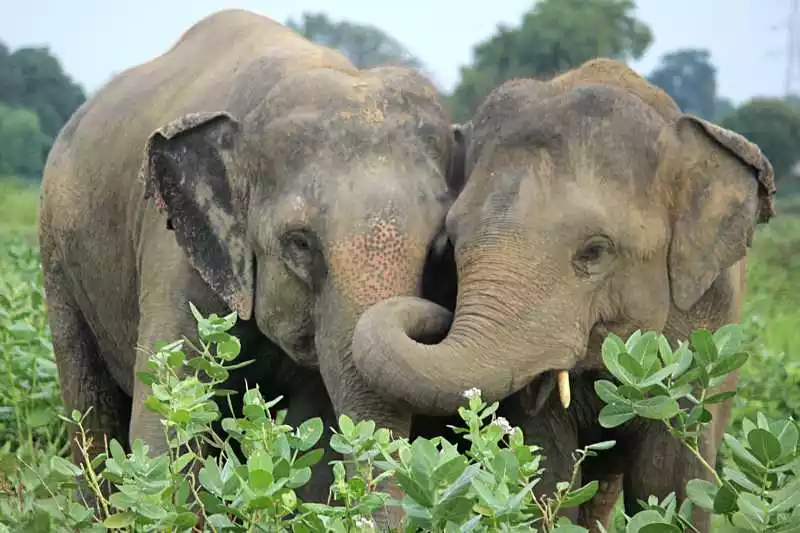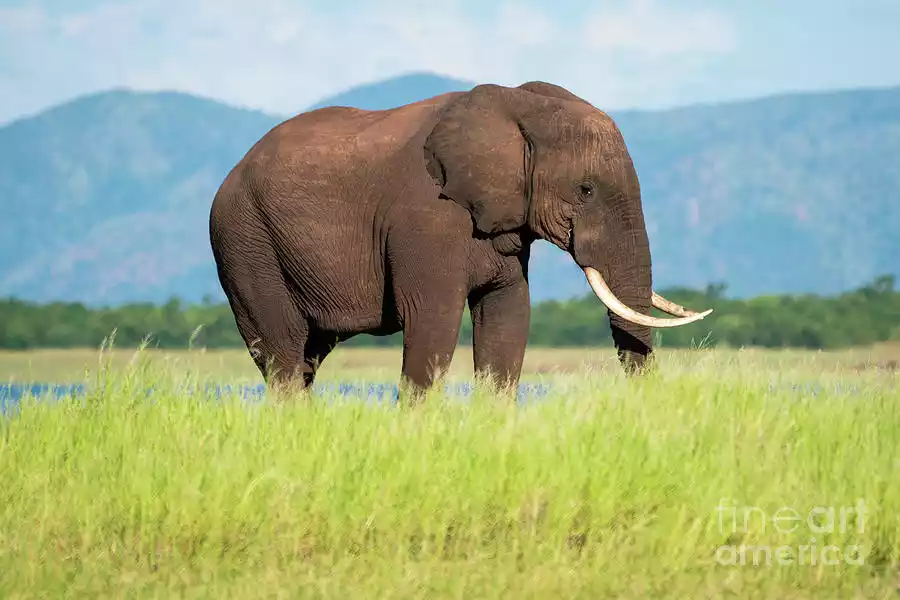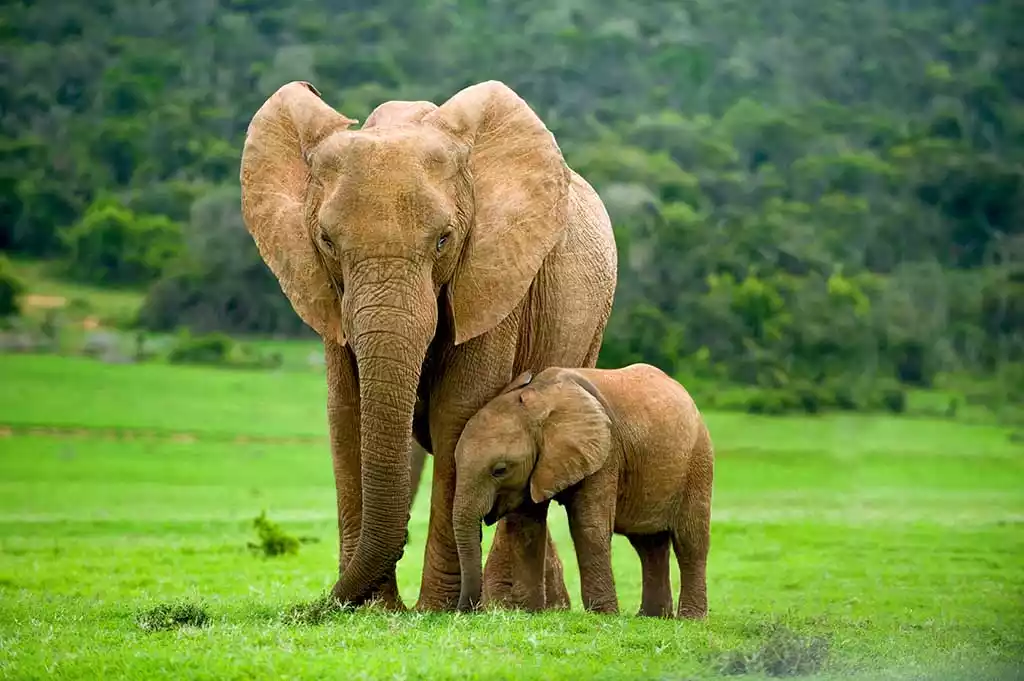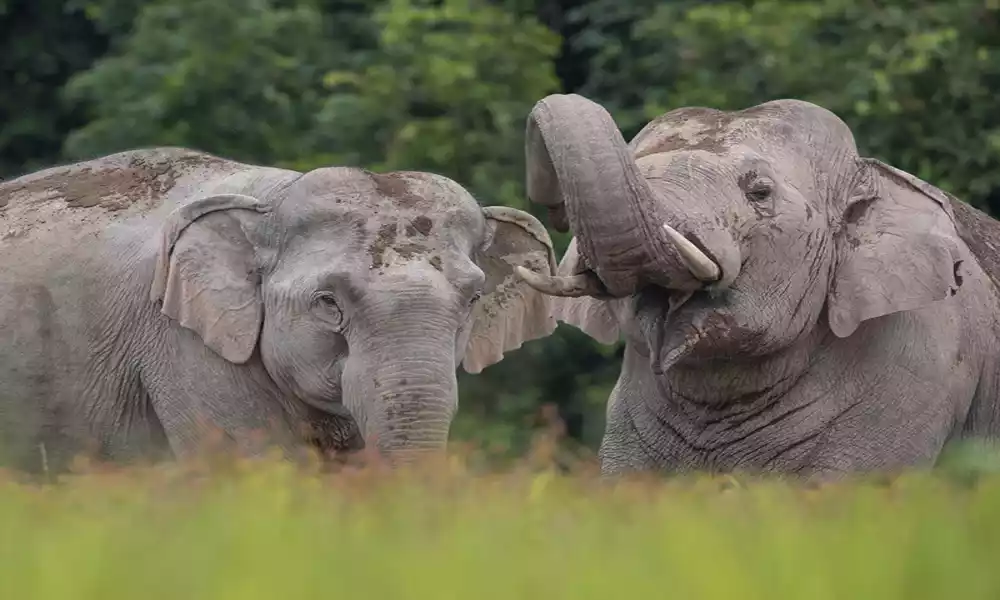Elephants, the largest land animals on Earth, exhibit fascinating gender differences that shape their lives in unique ways. In this concise exploration, we’ll uncover the essential distinctions between male and female elephants, touching on their physical characteristics, social roles, and the significance of these differences in conservation efforts.
From the towering bull elephants to the nurturing matriarchs, let’s delve into the intriguing world of these majestic creatures and discover what sets them apart.
A brief overview of elephants as a species
Elephants, the largest land mammals on Earth, are known for their massive size, iconic trunks, and complex social structures. They belong to the family Elephantidae and consist of three extant species: African Bush Elephant, African Forest Elephant, and Asian Elephant.
These herbivorous giants play a critical role in their ecosystems by shaping vegetation and are revered for their intelligence and cultural significance. However, they face threats such as habitat loss and poaching, making their conservation a global concern.
Explanation of sexual dimorphism in elephants
Sexual dimorphism in elephants refers to the distinct physical differences between male and female individuals of the same species.

In the case of elephants, these differences are particularly pronounced and serve various biological and behavioral functions:
- Size and Weight: One of the most noticeable aspects of sexual dimorphism in elephants is their size. Male elephants, known as bulls, are significantly larger and heavier than females, or cows. This difference in size is primarily due to the bulls’ need for greater physical power during competition for mates and establishing dominance.
- Tusks: Perhaps the most iconic feature showcasing sexual dimorphism in elephants is the presence of tusks. Bulls typically have large, curved tusks that can weigh several hundred pounds each, while females have smaller tusks or, in some cases, no tusks at all. These tusks are used for various purposes, including digging for water, stripping bark from trees, and occasionally in combat or displays of dominance among males.
- Body Shape: Male elephants often exhibit a more robust and stocky body shape compared to females, which can be more streamlined. This difference in body shape corresponds to their distinct roles in the herd and their varied physical needs.
- Reproductive Organs: Obviously, males and females have different reproductive organs. Bulls have external genitalia, including a penis and testes, while cows have internal reproductive organs, including ovaries and a uterus. This difference in reproductive anatomy is essential for their respective roles in mating and reproduction.
- Secondary Sexual Characteristics: In addition to primary physical differences, males and females may exhibit secondary sexual characteristics. For example, during mating seasons, male elephants may experience physiological changes, such as increased testosterone levels, which can lead to heightened aggressiveness and dominance displays.
- Social Roles: Sexual dimorphism in elephants also extends to their social roles. Female elephants typically form close-knit family groups led by a matriarch, while males are more solitary or form loose associations with other males. This social divergence is related to their size and the demands of their respective roles within the herd.
Understanding sexual dimorphism in elephants is crucial for comprehending their ecological roles, behavior, and conservation. It highlights the specialized adaptations that have evolved in response to the different functions and challenges faced by males and females within elephant society.
Male vs Female Elephants in the comparison chart
Here’s a concise comparison chart highlighting the key differences between male and female elephants:
| Aspect | Male Elephants (Bulls) | Female Elephants (Cows) |
|---|---|---|
| Size and Weight | Larger and heavier (up to 14,000 lbs) | Smaller and lighter (up to 6,000 lbs) |
| Tusks | Prominent, large, curved tusks | Smaller tusks or none in some populations |
| Body Shape | Robust and stocky | Streamlined and slender |
| Reproductive Organs | External genitalia (penis, testes) | Internal reproductive organs (ovaries, uterus) |
| Estrus Cycle | Absent estrus cycle | Well-defined estrus cycle (heat) every 13-17 weeks |
| Social Structure | Solitary or loosely associated with other males | Live in tight-knit family groups led by a matriarch |
| Parental Role | Limited involvement in parenting | A central role in parenting, caregiving, and guidance |
| Mating Behavior | Engage in courtship and competition during mating seasons | Display behavioral changes during estrus to attract males |
| Role in Herd | Often solitary or form male groups | Hold leadership roles and maintain social cohesion |
| Vocalizations | Vocalize less frequently | Use vocalizations for social bonding and communication |
| Conservation Concerns | Targeted by ivory poaching | Face threats like habitat loss and human-wildlife conflict |
These differences showcase the distinct roles and adaptations of male and female elephants within their social and ecological contexts.
Physical Differences
Sexual dimorphism in elephants leads to significant physical differences between males (bulls) and females (cows).
Here are the primary physical distinctions:
- Size and Weight:
- Males: Bull elephants are considerably larger and heavier than cows. They can weigh up to 12,000 to 14,000 pounds (5,400 to 6,350 kilograms) or more. The largest bull elephants may stand over 13 feet (4 meters) tall at the shoulder.
- Females: Cows are noticeably smaller, with an average weight ranging from 4,000 to 6,000 pounds (1,800 to 2,700 kilograms). Their shoulder height typically reaches around 8.2 to 9.8 feet (2.5 to 3 meters).
- Tusks:
- Males: Bulls possess large, curved tusks that can grow several feet in length and weigh hundreds of pounds. These tusks are used for various purposes, including digging, stripping bark, and occasionally in combat or displays of dominance.
- Females: Female elephants may have smaller tusks or, in some populations, no tusks at all. These tusks are generally much shorter and less pronounced compared to those of males.

- Body Shape:
- Males: Bull elephants often exhibit a more robust and stocky body shape, with a thick neck and a larger overall frame. Their size and strength are adapted for competing with other males for access to females.
- Females: Cows tend to have a more streamlined and slender body shape. Their physical structure is adapted for nurturing and protecting their young and foraging for food.
- Head and Face:
- Males: Male elephants often have larger, more prominent heads with thicker necks and relatively broad faces. Their forehead, known as the “boss,” may be more pronounced.
- Females: Female elephants typically have smaller heads and a more delicately shaped face.
- Genitalia:
- Males: Bulls have external genitalia, including a long, pendulous penis and visible testes.
- Females: Cows have internal reproductive organs, including ovaries and a uterus, and their genitalia are less visible externally.
These physical differences between male and female elephants are a result of evolutionary adaptations that serve their distinct roles within elephant society. Bulls’ size and tusks are advantageous for competing with rival males during mating seasons and establishing dominance, while cows’ physical attributes are tailored to their roles as caregivers and foragers within their family groups. Understanding these differences is essential for comprehending the complex behavior and ecology of elephants.
Reproductive Differences
Reproductive differences between male and female elephants (bulls and cows) are significant and are key to their respective roles in the species’ reproduction.
Here are the primary reproductive distinctions:
- Estrus Cycle:
- Females (Cows): Female elephants have a well-defined estrus cycle, also known as the “heat” or “reproductive cycle.” This cycle typically occurs every 13 to 17 weeks, and it involves a period of heightened fertility when a cow is receptive to mating. During estrus, a cow may display behavioral and physiological changes, such as increased vocalizations, restlessness, and a swollen vulva.
- Males (Bulls): Unlike females, male elephants do not have an estrus cycle. Instead, they are sexually active and capable of mating throughout the year. Their readiness for mating is not tied to a specific cycle but is influenced by social and environmental factors.
- Reproductive Organs:
- Females (Cows): Cows have internal reproductive organs, including ovaries, a uterus, and a cervix. They have a single pair of mammary glands for nursing their calves.
- Males (Bulls): Bulls have external genitalia, including a long, pendulous penis and visible testes. Their testes are located inside their body near the kidneys and descend into the scrotum when they are sexually mature.
- Parental Investment:
- Females (Cows): Female elephants play a crucial role in parenting and invest significantly in the care of their offspring. After a gestation period of about 22 months, a female gives birth to a single calf. Cows are responsible for nursing, protecting, and teaching their young.
- Males (Bulls): Male elephants have limited involvement in parenting. They may interact with calves within their family groups but are not directly responsible for their care. Males often lead more solitary lives or form loose associations with other males, focusing on activities such as foraging and mating.
- Mating Behavior:
- Females (Cows): During estrus, cows signal their readiness to mate through specific behaviors and pheromones, attracting potential mates. Dominant bulls may compete for the opportunity to mate with receptive females.
- Males (Bulls): Bulls engage in mating behavior when they encounter receptive females. This includes courtship displays and physical interactions with the female to establish mating access.
- Mating Age:
- Females (Cows): Female elephants typically reach sexual maturity around 9 to 13 years of age and can reproduce throughout their lives.
- Males (Bulls): Male elephants usually become sexually mature later than females, around 12 to 15 years of age. However, they may not successfully compete for mating opportunities until they are larger and more dominant, which can take longer.
These reproductive differences are fundamental to the reproductive strategies of male and female elephants. While females invest significantly in raising their offspring, males must compete for mating opportunities, often engaging in complex social interactions and displays to secure their reproductive success. Understanding these distinctions helps shed light on the intricate dynamics of elephant societies and their conservation needs.
Communication and Behavior
Elephants, both males (bulls) and females (cows), are renowned for their complex communication and behavior. These gentle giants utilize a range of methods to interact and express themselves within their social groups and in their environment.
Here’s a brief overview:
- Vocalizations:
- Elephants communicate through a variety of vocalizations, including trumpets, rumbles, and roars.
- Females often use vocalizations to maintain social bonds within their family groups.
- Males employ vocalizations during mating seasons and dominance displays.
- Physical Signals:
- Body language plays a significant role in communication.
- Ears held open or flapping can signify excitement or agitation.
- Tail movements, head gestures, and trunk postures convey various emotions and intentions.
- Chemical Signals:
- Elephants release pheromones through urine and secretions, which convey information about their reproductive state.
- These chemical cues are crucial for males in identifying receptive females during estrus.
- Social Structure:
- Female elephants live in tight-knit family groups led by a matriarch.
- Males are often more solitary or form loose associations with other males, and their interactions are characterized by dominance displays.
- Role in Herd:
- Females hold central roles in elephant herds, providing wisdom and guidance.
- Males may take on leadership roles in specific situations, such as leading a group to resources or during mating competitions.
Understanding these communication and behavior patterns is essential for appreciating the intricate dynamics of elephant societies, where individuals, whether male or female, contribute to the collective well-being and survival of the species.
Female-centric Conservation
Female-centric conservation is an approach to wildlife conservation that places a strong emphasis on protecting and supporting female individuals of a species. This approach recognizes the crucial roles that females play in the survival and sustainability of a population. While it can apply to various species, it’s particularly relevant in the context of elephants and other matriarchal animals.

Key aspects of female-centric conservation include:
- Protection of Matriarchs: Matriarchs are the experienced and knowledgeable female leaders within elephant herds. They play a central role in decision-making, navigation, and resource access. Protecting matriarchs ensures the stability and survival of the entire herd.
- Reproductive Success: Female-centric conservation focuses on ensuring the reproductive success of female animals. This involves providing a safe and stable environment for them to give birth and raise their young. It also includes efforts to reduce threats such as poaching and habitat loss, which can disrupt reproduction.
- Preserving Genetic Diversity: Protecting female individuals is vital for preserving the genetic diversity of a population. A diverse gene pool enhances a species’ ability to adapt to changing environments and resist diseases.
- Anti-Poaching Efforts: Many female animals, including elephants, are disproportionately targeted by poachers for their tusks, horns, or other valuable body parts. Female-centric conservation includes rigorous anti-poaching measures to protect females from these threats.
- Habitat Preservation: Maintaining suitable habitats for female animals is crucial. It involves safeguarding ecosystems that provide the necessary resources for females to thrive, feed, and raise their offspring.
- Research and Monitoring: Studying female individuals is essential for understanding population dynamics and behaviors. Conservationists often focus on tracking and researching female animals to gain insights into the health and challenges facing the species.
- Community Engagement: Engaging local communities in conservation efforts, especially those living near the habitats of female-centric species, is vital. Such engagement can lead to more effective protection measures and sustainable coexistence.
Female-centric conservation recognizes that the survival of many species, particularly those with matriarchal or female-dominated social structures, heavily depends on the well-being of female individuals. By prioritizing the protection and support of females, this approach contributes to the overall conservation and preservation of these remarkable creatures and the ecosystems they inhabit.
Conclusion
The intricate world of elephants reveals a tapestry of diversity and interdependence. From their immense physical differences to their complex social structures and crucial roles in conservation, male and female elephants are emblematic of the wonder and fragility of our natural world.
As we explore the vast realm of these majestic creatures, we uncover the profound impact of sexual dimorphism, the fascinating nuances of communication and behavior, and the critical importance of female-centric conservation efforts.
Through understanding and appreciating these distinctions, we gain insight into the remarkable lives of elephants and the urgent need to protect their future. These gentle giants teach us not only about their own unique existence but also about the intricate web of life on Earth. It is a reminder of our shared responsibility to safeguard these magnificent beings and the ecosystems they call home.




